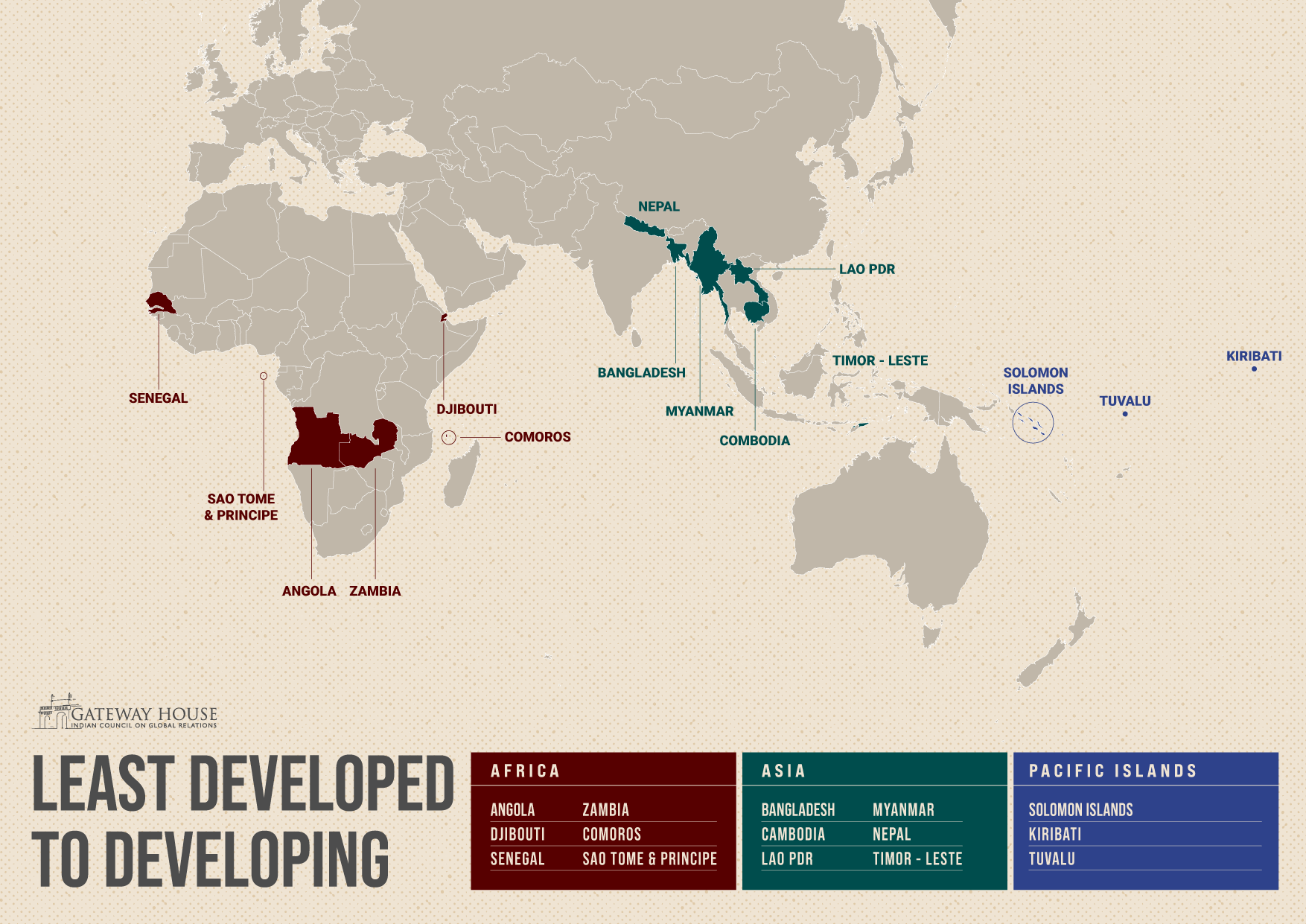The category of Least Developed Countries (LDCs) holds a pivotal place in the global community since it was codified in November 1971, as it represents the most vulnerable and marginalized populations facing significant developmental challenges. The transition from LDC to developing country indicates a major milestone in a nation’s development journey. It reflects progress in economic growth, human development, and political stability, signifying that a country has overcome many of the challenges associated with poverty, underdevelopment, and vulnerability. This transition also opens opportunities for increased access to international trade, investment, and development assistance on more favorable terms.
On December 13, 2023, Bhutan joined the ranks of developing countries, marking its departure from LDC category. Despite the challenges posed by the COVID-19 pandemic, Bhutan has made significant strides towards its development goals. This achievement sets the stage for 15 more countries across Asia, Africa and the Pacific Islands to follow suit in the coming years, signaling a broader trend of progress and hope for global development.
This infographic shows the number of LDCs which are on the path to graduation. Of the original 45 countries in Asia, Africa, Latin America and the Pacific Islands listed as LDCs, seven have graduated to developing country status: Botswana (1994), Cabo Verde (2007), Maldives (2011), Samoa (2014), Equatorial Guinea (2017), Vanuatu (2020), and the latest, Bhutan (2023).

Angola, the Solomon Islands, and Sao Tome and Principe will graduate in 2024, while Bangladesh, Laos and Nepal will change status in 2026. Kiribati and Tuvalu will follow. Cambodia, Comoros, Djibouti, Senegal, and Zambia met their criteria in 2021 but continue to retain their LDC status to benefit from quota-free market access for their products[1]. Myanmar and Timor-Leste have been deferred to 2024.[2]
Significantly, three of the 15 countries are from South Asia. This will give a fillip to the region which, for the first time, is looking at economic integration. While it is centered around India with its rising GDP and its attractiveness as a destination for investment moving away from China, the economic emergence of the neighborhood will create another productive regional bloc like ASEAN.
The process of graduation is set by the UN. The list of LDCs is reviewed by the Committee for Development Policy (CDP), an independent expert committee that reports to the UN Economic and Social Council (ECOSOC). Every three years, the CDP recommends countries for admission or graduation based on their performance in the following indicators:[3]
- Gross national income (GNI) per capita: This is based on a three-year average estimate of the GNI per capita in U.S. dollars. The threshold for inclusion in the LDC list is $1,088 or below, while the graduation threshold is $1,306 or above.
- Economic and Environmental Vulnerability Index (EVI): This index comprises eight indicators, equally split between economic and environmental shocks. A lower EVI indicates lower economic and environmental vulnerability, with inclusion and graduation thresholds set at 36 or above and 32 or below, respectively.
- Human Assets Index (HAI): This comprises six indicators—three on education and three on health. An HAI of 66 or above signifies a higher development of human capital, while 60 or below keeps countries underqualified.
To graduate to developing country status, a country must meet at least two of the three criteria for two consecutive triennial reviews. However, there are two exceptions to this mandate. First, highly vulnerable or low HAI countries, like Myanmar, are eligible for graduation only if they meet the other two criteria by a sufficiently high margin. Second, countries are also eligible for graduation if their GNI is more than thrice the graduation threshold, i.e., $3,918 – even if they do not meet the other two criteria.
Countries on the path of graduation (figures as per 2023)
| Region | Country | Gross National Income per capita, $ (GNI) | Economic Vulnerability Index (EVI) | Human Assets Index (HAI) |
| Asia | Timor – Leste | 2,017 | 68.56 | 38.80 |
| Bangladesh | 2,477 | 77.26 | 26.68 | |
| Cambodia | 1,549 | 74.98 | 29.98 | |
| Lao PDR | 2,539 | 74.17 | 26.91 | |
| Myanmar | 1,353 | 78.52 | 24.35 | |
| Nepal | 1,229 | 77.36 | 24.57 | |
| Africa | Djibouti | 3,029 | 63.06 | 51.86 |
| Angola | 2,322 | 54.04 | 44.51 | |
| Senegal | 1,496 | 69.10 | 44.52 | |
| Zambia | 1,203 | 68.94 | 44.82 | |
| Comoros | 1,580 | 70.38 | 40.39 | |
| Sao Tome and Principe | 2,135 | 91.03 | 37.62 | |
| Pacific Islands | Solomon Islands | 2,349 | 73.30 | 47.58 |
| Kiribati | 2,897 | 82.10 | 50.73 | |
| Tuvalu | 7,735 | 89.05 | 43.14 |
Source – United Nations (DESA)
Aditya Shinde is a Research Assistant at Gateway House
Janya Gugnani and Sakshi Pawar are former interns, Gateway House
Infographic designed by Debarpan Das.
This infographic was exclusively designed for Gateway House: Indian Council on Global Relations. You can read more exclusive content here.
For permission to republish, please contact outreach@gatewayhouse.in
©Copyright 2024 Gateway House: Indian Council on Global Relations. All rights reserved. Any unauthorised copying or reproduction is strictly prohibited.
References
[1] Once a country graduates from LDC status, the benefits associated with that status such as duty-free and quota-free (DFQF) market access for LDC products are no longer applicable. Retaining LDC status allows these countries to continue receiving support for their development efforts.
[2] Myanmar faces ongoing political instability, exemplified by the military coup in February 2021, which disrupted governance and impeded development progress. Timor-Leste’s deferment can be attributed to its vulnerability to natural disasters, such as earthquakes and floods, which have hindered infrastructure development and economic growth. Moreover, both countries have been significantly impacted by the COVID-19 pandemic, exacerbating existing socio economic disparities and delaying progress towards graduating from LDC status.
[3] https://unctad.org/topic/least-developed-countries/list#:~:text=LDC%20graduation,Maldives%20in%20January%202011


